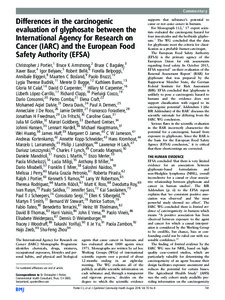Differences in the carcinogenic evaluation of glyphosate between the International Agency for Research on Cancer (IARC) and the European Food Safety Authority (EFSA)

Portier, Christopher J. ; et al.
Journal of Epidemiology and Community Health
2016
70
8
741-745
carcinogenic effects ; carcinogenicity ; comparison ; herbicide ; IARC ; methodology ; toxicity evaluation
Risk assessment and risk management
http://dx.doi.org/10.1136/jech-2015-207005
English
Bibliogr.
"The International Agency for Research on Cancer (IARC) Monographs Programme identifies chemicals, drugs, mixtures, occupational exposures, lifestyles and personal habits, and physical and biological agents that cause cancer in humans and has evaluated about 1000 agents since 1971. Monographs are written by ad hoc Working Groups (WGs) of international scientific experts over a period of about 12?months ending in an eight-day meeting. The WG evaluates all of the publicly available scientific information on each substance and, through a transparent and rigorous process,1 decides on the degree to which the scientific evidence supports that substance's potential to cause or not cause cancer in humans.For Monograph 112, 17 expert scientists evaluated the carcinogenic hazard for four insecticides and the herbicide glyphosate. The WG concluded that the data for glyphosate meet the criteria for classification as a probable human carcinogen.The European Food Safety Authority (EFSA) is the primary agency of the European Union for risk assessments regarding food safety. In October 2015, EFSA reported on their evaluation of the Renewal Assessment Report (RAR) for glyphosate that was prepared by the Rapporteur Member State, the German Federal Institute for Risk Assessment (BfR). EFSA concluded that ‘glyphosate is unlikely to pose a carcinogenic hazard to humans and the evidence does not support classification with regard to its carcinogenic potential'. Addendum 1 (the BfR Addendum) of the RAR discusses the scientific rationale for differing from the IARC WG conclusion.Serious flaws in the scientific evaluation in the RAR incorrectly characterise the potential for a carcinogenic hazard from exposure to glyphosate. Since the RAR is the basis for the European Food Safety Agency (EFSA) conclusion, it is critical that these shortcomings are corrected.
Digital
The ETUI is co-funded by the European Union. Views and opinions expressed are however those of the author(s) only and do not necessarily reflect those of the European Union or the ETUI.